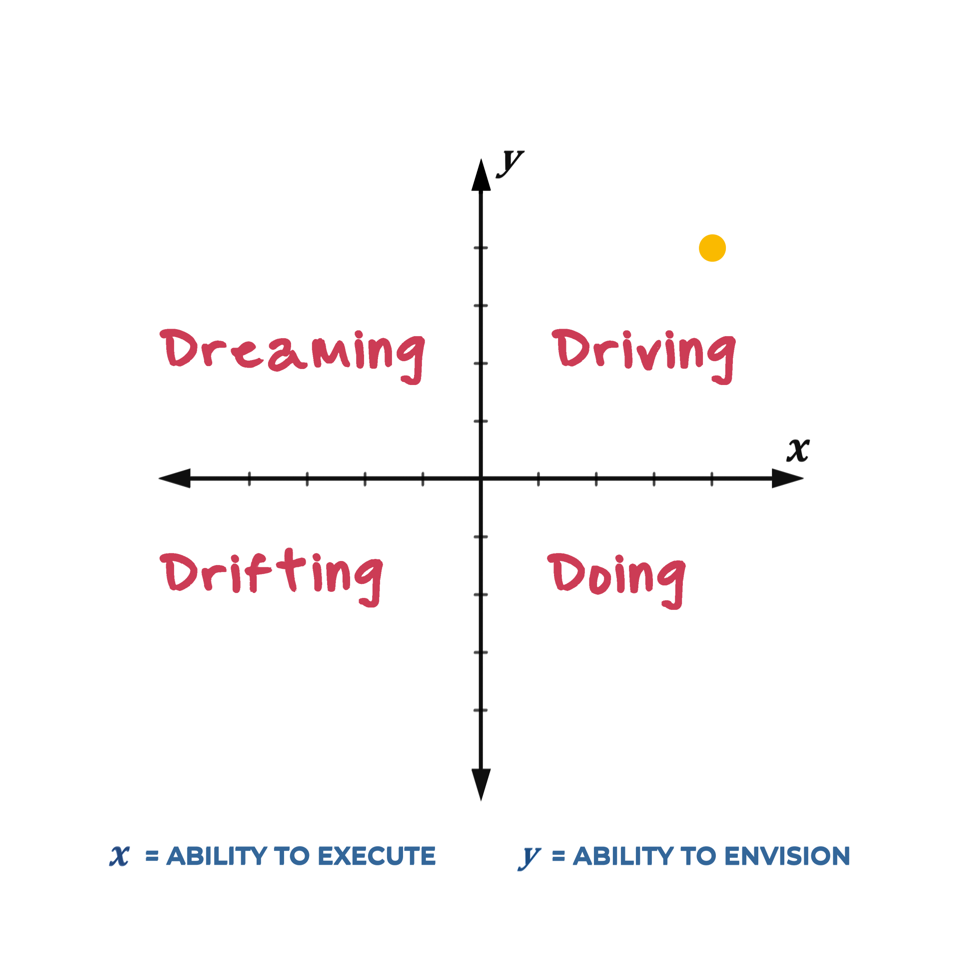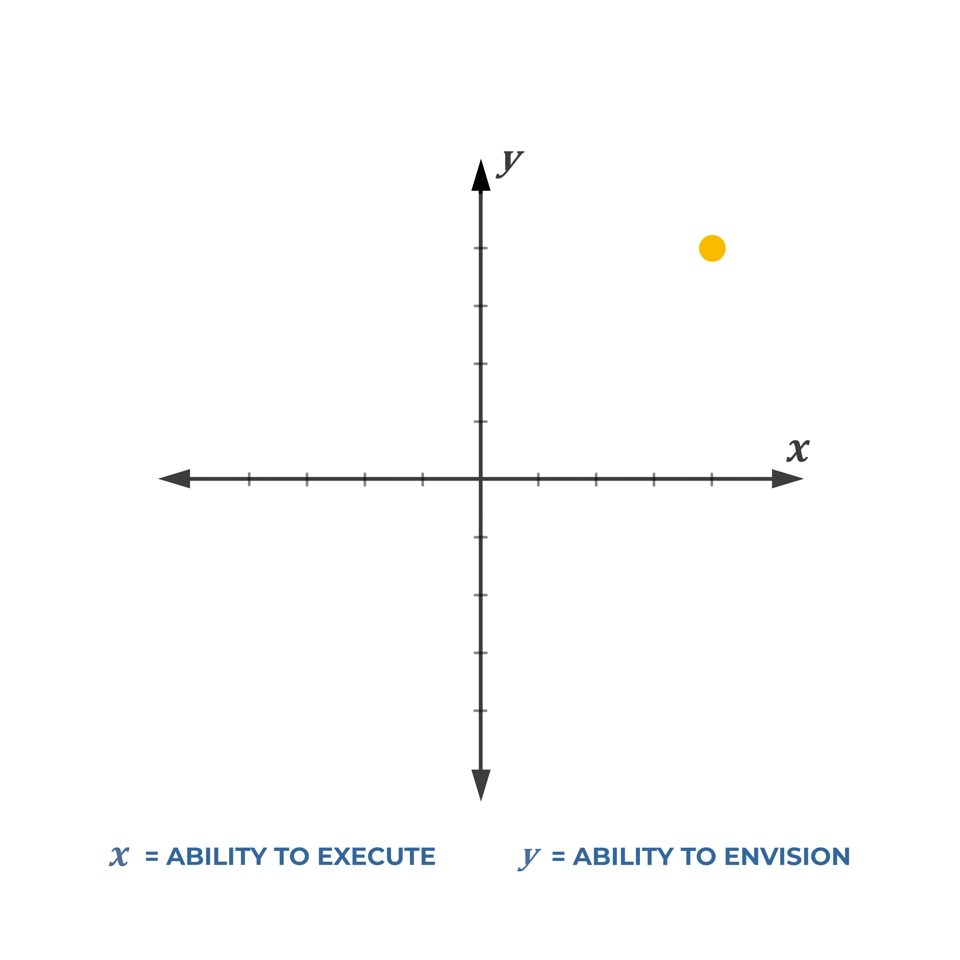Objective and consistent tools are essential for reviewing and evaluating the performance of your leadership team or organisation, so that you can provide focused support to enhance strategic and operational capability.
Following extensive research and experience at Vmax, we created an extremely insightful and incisive tool – the DRIVE model. We cross-reference 2 critical determinants of organisational success: the ability to envision a future and create an effective and compelling strategy, and the ability to execute effectively and efficiently on that strategy.
Using this method, we can map leadership teams and organisations into one of 4 quadrants, easily identifying areas for development and providing pathways for organisational growth.

Clearly the desired position is the top right quadrant where the leadership team or organisation can be seen (y) strongly envisioning the future, and (x) effectively working together to achieve the strategy.
Many leadership teams and organisations, however, sit within other quadrants. Some may value a high energy “can-do” culture, and excel at creative vision, yet lack the internal systems to effect change. Others may value a culture of stability and conformity, with considerable delivery expertise, yet lack the innovation and vision necessary to evolve and grow in a rapidly changing business environment. Yet other leadership teams and organisations may struggle both to envision a future state and to efficiently execute on their existing plan.
The DRIVE model’s simple two-axis approach enables us to map our leadership team or organisation into one of the quadrants depicted in the diagram. Visualising and understanding where we are can help enormously in terms of diagnosing the blockages to outstanding performance, and developing pathways towards transformative, sustainable growth
DRIFTING
The bottom left quadrant is occupied by organisations who do not have the ability to envision a future state and also are struggling to efficiently execute on their existing plan – these are characterised as DRIFTING. Such organisations tend to lack energy and focus and will often keep repeating past practice in the hope that it will deliver results. They are often unable to resolve operational delivery issues, so revenue streams fall, market positioning diminishes as competitors take more purposeful actions and so the cycle continues.
It can be hard for organisations to recognise that they are in this quadrant as entry itself is most frequently a drift rather than a purposeful positioning. This drift is generally either a function of low self-awareness, a feeling of helplessness about any power or influence over what is happening, or a lack of capability and competence in the leadership team to manage their way out of the pattern of failure.
Typical traits of DRIFTING organisations include:
- Low confidence in decision making
- Low engagement and energy across the organisation
- Fear of change accompanied by frustration at not being able to change
- Blame culture with a focus on external circumstances
DREAMING
Organisations that can envision a future state, but which tend to fail when it comes to operationalising their ambitions are typified as DREAMING – they know and understand where they need to get to but do not have the operational capability, competence, systems or determination to get there. These organisations and leadership teams will often talk a good game and either make excuses or rationalisations for non-delivery or keep changing their strategy to disguise the fact that they are not able to deliver effectively.
Interestingly, organisations with highly creative leadership teams will also often sit in this category as they tend to keep innovating new ideas and improvements without actually putting them into practice and/or fully embedding them before moving on to the next good idea. In this mode they are highly creative and able to easily envision a different way of working or a different future but their constant search for innovation gets in the way of operationalising and embedding their ideas, so the net effect is that the execution capability is weak.
Typical traits of DREAMING organisations include:
- Highly creative with a focus on new ideas and approaches
- Confident in their decision making about the future
- High energy ‘can-do’ culture
- Read widely and seek to incorporate learning into their practice
- Can often flit from one good idea to the next
- Get bored by routine and lose interest in implementation
- Poor track record of fully embedding change
- Often a frustrating environment for those not close to the creative thinkers
DOING
Some organisations demonstrate operational excellence on an ongoing basis but tend to not fully understand the strategic context within which they operate and are unable to clearly create and articulate a forward strategy that ensures they will be competitive in a changing world. Developments in these organisations tend to be incremental improvements or changes brought in by new hires. Consequently the status quo is either maintained or incrementally enhanced but in either case the primary focus is on DOING.
Organisations in the DOING quadrant can be highly effective in the current market conditions and they will often be confident in their capabilities because of their execution experience and expertise. The stability that this effective delivery brings tends to attract like-minded people who enjoy ‘getting the job done’ and organisations can be seen in this quadrant for many years quite successfully. Improvements tend to be slower and more incrementally focused though and they are typically the “early majority” and “late-majority” followers with innovations – waiting until concepts are proven or the market significantly shifts before moving themselves. History is full of once confident DOING organisations with significant market share until the market moved on without them.
Typical traits of DOING organisations include:
-
- Confident and assured in their capabilities
- High focus on getting it right
- See the benefit of marginal gains and sequential change
- Value stability and conformity
- Wary of change and not accomplished in managing complexity
- Low focus on innovation
- Rely on experience and trusted data sources to make decisions
- Often a frustrating environment for those who can see better ways of working
Driving
Clearly the desired position is the top right quadrant where the leadership team can be seen to be DRIVING its performance in terms of effective and seamless execution of a well-constructed and sound strategy. Teams in this quadrant will have a clear ambition and a well-defined goal deployment process such that each person knows what they need to do to contribute to delivery of the strategy as well as understanding their personal value contribution.
Typical traits of DRIVING organisations include:
- Highly engaged and collaborative leadership teams
- Co-creative development and implementation of ideas
- High focus on delivery
- Closely attuned to the market and changing customer needs
- High support / high challenge performance culture
Our experience of using the DRIVE model as a means of evaluating organisational performance shows that this is a simple, accessible, and yet highly insightful way to help leadership teams to understand how they are performing and, importantly, where they need to focus their endeavours and strengthen their capabilities. It is a very useful means to map and manage change as it enables teams to map where they are and where they aspire to be, prior to identifying the specific actions and behaviours required to navigate the transformational journey.

